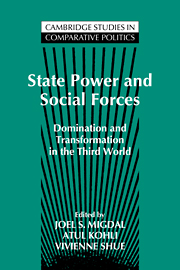Book contents
- Frontmatter
- Contents
- Preface
- List of contributors
- State Power and Social Forces
- Introduction: developing a state-in-society perspective
- PART I THEORETICAL AND METHODOLOGICAL CONSIDERATIONS
- PART II STATES: EMBEDDED IN SOCIETY
- PART III SOCIAL FORCES: ENGAGED WITH STATE POWER
- 6 Labor divided: sources of state formation in modern China
- 7 Business conflict, collaboration, and privilege in interwar Egypt
- 8 A time and a place for the nonstate: social change in the Ottoman Empire during the “long nineteenth century”
- 9 Peasant–state relations in postcolonial Africa: patterns of engagement and disengagement
- 10 Engaging the state: associational life in sub-Saharan Africa
- PART IV CONCLUSION
- Index
6 - Labor divided: sources of state formation in modern China
Published online by Cambridge University Press: 05 June 2012
- Frontmatter
- Contents
- Preface
- List of contributors
- State Power and Social Forces
- Introduction: developing a state-in-society perspective
- PART I THEORETICAL AND METHODOLOGICAL CONSIDERATIONS
- PART II STATES: EMBEDDED IN SOCIETY
- PART III SOCIAL FORCES: ENGAGED WITH STATE POWER
- 6 Labor divided: sources of state formation in modern China
- 7 Business conflict, collaboration, and privilege in interwar Egypt
- 8 A time and a place for the nonstate: social change in the Ottoman Empire during the “long nineteenth century”
- 9 Peasant–state relations in postcolonial Africa: patterns of engagement and disengagement
- 10 Engaging the state: associational life in sub-Saharan Africa
- PART IV CONCLUSION
- Index
Summary
Recent generations of labor historians, disappointed by the failure of twentieth-century workers to live up to the exalted expectations of Karl Marx and Frederick Engels, have focused their explanatory energies on the limitations of proletarian politics. Central to this new wave of scholarship is attention to the fragmented character of labor. Divided along lines of gender, age, ethnicity, and skill, workers are shown rarely to have acted in the cohesive, class-conscious fashion predicted by communist visionaries. There is a pessimistic tone to much of this recent analysis, as students of labor reluctantly come to grips with the shortcomings of their object of study. There is also a note of irony, as scholars discover that what little indigenous support there was for a radical labor movement tended to be concentrated in the most privileged sectors of the working class, far removed from the heroic proletariat of the Communist Manifesto.
In wrestling with the unfulfilled promises of Marxism, studies of labor have been obsessed with “why not” questions: Why did workers not develop a class identity? Why did workers, especially the most downtrodden of them, not flock to radical political parties? Why did working-class parties, especially in advanced capitalist societies, not engineer Marxist revolutions? When phrased in this manner, the questions prompt one to search for sources of weakness in the working class. And that search has led to sophisticated analyses of divisions within the labor force.
- Type
- Chapter
- Information
- State Power and Social ForcesDomination and Transformation in the Third World, pp. 143 - 173Publisher: Cambridge University PressPrint publication year: 1994
- 4
- Cited by



